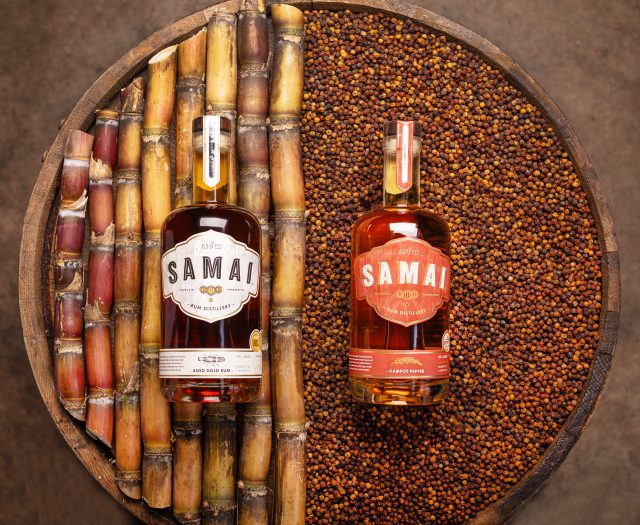This website uses cookies so that we can provide you with the best user experience possible. Cookie information is stored in your browser and performs functions such as recognising you when you return to our website and helping our team to understand which sections of the website you find most interesting and useful.
How Samai Distillery converts Cambodian drinkers to rum
As the first Cambodian rum distillery, Samai pioneered cane spirits in a rice spirit kingdom. Co-founder Daniel Pacheco tells Dan Q Dao how cocktails, competitions, and Kampot peppers won over local drinkers.

When Daniel Pacheco first moved to Cambodia 14 years ago, good rum was still hard to come by. Originally from rum-loving Venezuela, Pacheco recalls being homesick for the taste of a quality cane spirit.
“Back then, it was impossible to even find imported rums,” Pacheco says. “So any time we got our hands on a nice bottle, we would always sit around, enjoy it together, and talk about home.”
Working in rural solar energy at the time, Pacheco says he stumbled upon sugarcane, grown primarily for the sugar industry, while visiting small villages in the Cambodian countryside. Despite the abundance of sugarcane, he noticed Cambodians were only making rice spirits.
Linking up with high-school friend and co-founder Antonio Lopez, Pacheco launched Samai Distillery — the name means “modern” or “forward-thinking”. To create the molasses-based rum, they hired Moang Darachampich, who remains Samai’s master distiller and production manager a decade later.

“We wrote a job description looking for ‘a master distiller with 10 years of experience,’” he says. “We got one application, and it was a good one. She had a master’s in chemical engineering, specialised in food manufacturing, and had done her thesis in fermentation. We brought in rum experts to teach her the basics but she took off from there.”
With a team in place, Pacheco set about converting Cambodians to a rum created in the Venezuelan image. This initially proved difficult. To draw consumers into the door, the Samai team first opened the distillery as a rum bar serving cocktails, even before their own rum was ready. Still, the audience at the time was primarily westerners.
“There’s a very strong whiskey and beer tradition here. At the beginning, it was pretty much all expats and a few tourists,” Pacheco says. “We really struggled to get Cambodians to come in and even want to try it. We actually had very negative reactions when we told any of our local friends that we were making Cambodian rum.”
It wasn’t until the distillery garnered international attention that Cambodian consumers became more curious. Launched in 2014, the distillery’s flagship Samai Gold Rum, an añejo flavoured with local wild honey, has won acclaim in international competitions.
“We started sending our rums to big competitions in London, San Francisco, and Madrid—surprisingly, we ended up winning in pretty much all these competitions,” he says. “I think the key was getting Cambodian products to be recognised internationally. Once this happened, people started coming to taste the rum, see the distillery, and learn about what we’re doing. This shift happened very quickly, in just a few years.”

But it wasn’t all about catering to an international gaze, says Pacheco. Samai’s second release is the Kampot Pepper Rum, made with a famed sweet red variety of peppercorn grown in Cambodia. Technically a spiced rum, the product has become a cult favourite among both expats and locals alike.
“We tried many different Cambodian ingredients,” Pacheco says. “But the moment we tried the first drop of rum distilled with the kampot pepper, everyone fell in love with it. It’s what gets people’s attention because there is nothing else like it on the market.”
Today, Samai exports about 30% of its production to France, Singapore, Spain, and Poland—its fastest-growing market. The remaining 70% is sold domestically — and can now be found at all of Cambodia’s top hotels and Cambodian cocktail bars, like Sora Bar at the Rosewood Phnom Penh.
And as for Samai’s rum bar, Pacheco says they still open for cocktails on Thursday and Saturday, in addition to hosting regular events, including some with live music. The cocktail menu includes longtime favourites including riffs on a Cuba Libre and a Negroni, as well as specials and secret orders.

“It went from 90% expat, and 10% Cambodian coming through the bar to the complete opposite — the fact that it’s now 90% Cambodian—I think that was something that made us very proud.”
Going beyond convincing Cambodians to just drink rum, Pacheco says he’s proud to have helped create a product that makes Cambodians truly proud of their country — and the high quality of its raw goods. He reveals that the team recently discovered the identity of a “secret buyer” purchasing in large quantities.
“It turns out this buyer was pretty high up in the government,” he says. “Once we found out he was serving it to foreign dignitaries and other people visiting Cambodia, we got in touch and created a special label and bottling. It’s not something we ever aimed to do, or really even thought about, but knowing that even people in the government were using Samai to represent Cambodian quality was amazing.”

